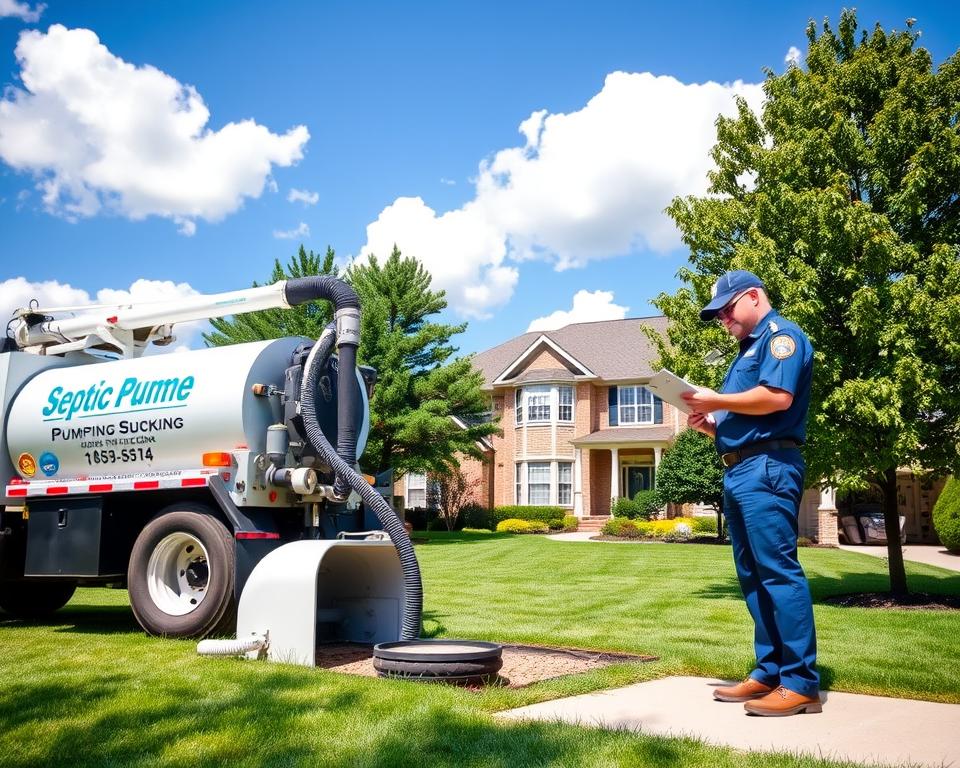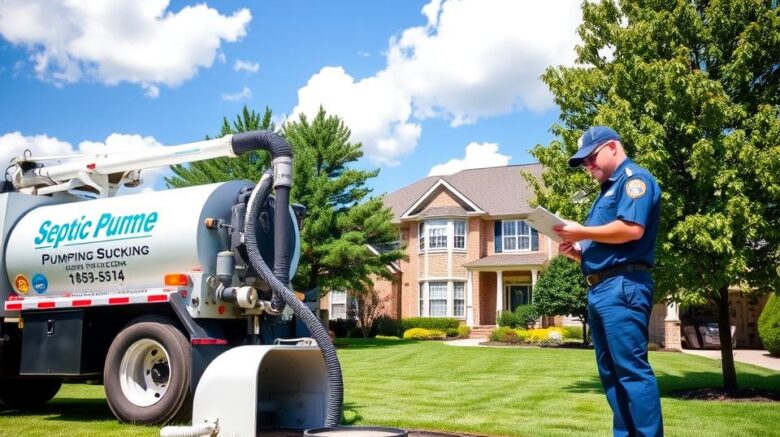Septic Tank Pumping Price Explained
Have you paused to consider about the true cost of keeping your septic system up to date, or whether you’re spending too much? It’s critical for householders to grasp the specifics of septic tank pumping prices. Generally, the fee hovers around $420, though it can range significantly. This spread comes from factors like your tank’s capacity and geographic area – septic tank cleaning cost.
Scheduled servicing of your septic tank avoids expensive fixes, emphasizing the value of understanding service costs. We aim to examine septic tank service pricing comprehensively. This will allow you to budget money‑wise for your system’s care.
Main Points
- Average septic tank pumping comes to about $420.
- Prices can sit between $290 and $560 based on various conditions.
- Regular upkeep prevents more expensive repairs later on.
- Most households need pumping every 3–5 years.
- Family size and consumption can impact pumping schedule.
Recognizing the Value of Septic Tank Pumping
Septic tank pumping is essential for a well‑functioning wastewater system. It extracts solids that, if ignored, cause clogs. Timely pumping also prevents bad smells but also dodges hefty repair costs.
Overlooking septic tank maintenance can compromise our extensive reliance on these systems. Fortunately, affordable services minimize the risk of system failure. Routine upkeep lengthens your septic system’s life, guaranteeing trouble‑free operation.
Pricing for septic tank upkeep teaches the value of preventive care. Regular service detects problems early, avoiding major damage and hefty repair bills. Routine pumping is a smart move for homeowners to safeguard their asset and gain peace of mind.
Standard Fees for Septic Tank Pumping
Septic tank pumping commonly comes between $250 USD and $600 in cost. Usually, homeowners will spend about $400 USD for this necessary service. Fee differences are due to factors like capacity, property location, and how often maintenance is scheduled. Typical tanks, around 1,000 gallons, usually cost between $225 USD and $400.
Homeowners should realize the importance of allocating funds every 3–5 years for septic tank pumping. This routine care relies on the tank’s usage and size. It avoids more serious, costlier issues down the road, demonstrating to be both time and money‑efficient.

Variables Affecting Septic Tank Pumping Prices
Several factors are crucial in determining the cost of septic tank pumping. Knowing these details empowers homeowners to budget for these necessary services properly.
The capacity is significant immensely. Higher‑capacity tanks take more effort and resources to empty, which means increased fees. The reachability to your tank also noticeably impacts the price. Tanks installed deeply or in challenging locations require more time and special tools from technicians, thus boosting the labor costs.
Costs can swing widely based on where you live. This is due to shifts in local labor rates and disposal fees. For example, some areas carry higher charges for disposing of waste, affecting the final service cost. Moreover, tanks with significant solid waste accumulation also see additional fees—anywhere from $100 USD to $300. Plus, the more frequently a tank requires pumping—due to higher system load—the higher the ongoing expenses.
Septic Tank Capacity and Its Effect on Cost
The volume of your septic tank clearly affects the cost of its upkeep. Smaller tanks, say, those that can hold 750 gallons, typically have lower pumping costs, generally ranging from $175 USD to $300. On the other hand, bigger tanks, capable of holding up to one thousand seven hundred fifty gallons, may incur charges between $400 and $700. The majority of single‑family residences use tanks that hold between 1,000 to twelve‑fifty gallons, offering a balance between volume and performance.
Homes with smaller tanks or higher numbers of occupants often require more frequent pumping services, which increases the overall expense. It’s vital to conduct regular septic tank inspections in these situations. This ensures the tank does not overflow or malfunction, which helps avoid additional costs. By comprehending the relationship between tank size and service fees, homeowners can take well‑informed choices regarding their septic systems and their upkeep demands.
Regional Differences in Septic Tank Pumping Costs
Septic tank pumping costs can shift substantially based on region. In urban areas, the expenses are typically higher due to local septic services experiencing increased overhead. For example, Minneapolis, MN residents may spend between $180 and $280 USD, while those in Portland, OR could see prices from $440 USD to $750 USD.
The reasons behind these gaps are varied. They include cost of living, demand for septic specialists, and local regulations. In places where septic services are in short supply, homeowners might pay more due to the fewer choices. Moreover, strict regulations in some regions can raise the need for higher compliance fees, impacting the cost of services.
Being knowledgeable about these geographic cost variances is crucial for homeowners. It allows them to forecast their septic maintenance budget more realistically. By being aware of local pricing, they can seek quotes from specialists wisely, servicing their septic system effectively without overspending.
Extra Expenses to Consider with Septic Tank Pumping
Homeowners often fail to consider various additional maintenance costs associated with septic tank pumping. The primary cost includes just the basic service, not covering other potential expenses. Being aware of these can aid in building a complete budget.
CCTV inspections, for instance, fall between $250 to $500. They offer a minimally disruptive look into the system’s condition. Additionally, filter rinsing, which if overlooked can lead to system failures, represents another cost.
The range for repairs can be broad, from $100 to $4,000 USD, based on the specific issues. This range emphasizes the necessity of factoring in additional maintenance costs for future budgeting.
Allocating Funds for Septic Tank Maintenance
When planning for septic tank upkeep, it’s vital to adopt a all‑inclusive view. This covers several critical elements. Owing to variable factors, the cost of maintenance can change considerably. Because of this, smart financial planning is essential.
To keep your system functions reliably and to sidestep unforeseen bills, keep these timelines and services in mind:
- Scheduled pumping: This service is generally required every 3 to 5 years.
- Inspections: Plan for around $250 to $1,180 USD for inspections every three years.
- Potential repairs: Set aside a fund for emergency repairs, which can occur unexpectedly.
Establishing a routine maintenance calendar with a dependable septic service is crucial. By anticipating these expenses, homeowners can evade the steep costs tied to neglect. This strategy guarantees the durability and effectiveness of their septic systems.
Early Warnings That Your Septic Tank Needs Pumping
Staying alert to your septic system’s condition is crucial. Identify the initial indicators that suggest your septic tank needs pumping. Doing so can prevent significant damage and lower repair costs.
- Slow drains: Water taking longer to drain in sinks, tubs, or toilets could indicate your septic tank is overflowing.
- Unpleasant odors: Bad smells near the septic tank or in your yard are often clear indicators of a problem.
- Gurgling sounds: Odd gurgling from your plumbing might show air is trapped because of a blockage.
- Wet spots: Standing water or greener grass sections near the drain field point to waste seepage from the tank.
- Dark green grass: Grass that is darker and appears robust around the drain field may point out leakage of nutrients, hinting at an issue.
Scheduled checks by septic system specialists can keep your tank is in proper order. Using experienced septic technicians for maintenance avoids these issues, guaranteeing your system’s longevity.
Benefits of Routine Septic Tank Inspections
Scheduled inspections are central to maintaining your septic system in top condition. They spot potential problems before they turn into costly repairs. By engaging professionals for these checks, every part of your system receives a thorough assessment.
The process reviews multiple parts of your system, including waste levels and the drain field’s status. It confirms that critical parts, like baffles, work as they should. Finding issues sooner prevents dangerous overflows and shields the environment, helping both your home and the wider community.
Scheduling your septic tank inspected every three years can save you a lot of money. It stops bigger issues from developing due to neglect. This not only cuts on repair costs but also gives your peace of mind.
| Inspection Aspect | Importance |
|---|---|
| Waste Level Assessment | Prevents overflow and backups |
| Drain Field Evaluation | Identifies saturation and function |
| Component Functionality Check | Ensures proper system operation |
| Early Problem Detection | Saves on repair costs |
Strategies to Reduce Spending on Septic Tank Pumping Prices
Homeowners aiming to cut septic tank pumping costs have multiple strategic options. Setting up group services with neighbors is one smart method. This involves coordinating with others nearby to book services together, potentially landing group discounts. It’s a way to strengthen community bonds while managing expenses more efficiently.
Another practical approach is to enroll in maintenance plans with septic service providers. These plans often include discounted prices for regular check‑ups and pumpings, ensuring septic systems working properly at a lower cost. Homeowners are encouraged to ask about these plans when contacting service companies.
Keeping the septic tank easy to reach can also help reduce pumping expenses. Clear accessibility means there’s no requirement for extra labor charges. It’s wise to keep the area around the tank clear of clutter, making way for straightforward servicing.
Practicing certain habits helps in prolonging the time between pumpings as well. Reducing water usage and curbing garbage disposal use are important practices. These actions can significantly boost septic system health, lowering the need for regular maintenance. By embracing these habits, homeowners can successfully reduce their septic tank pumping costs, preserving their budgets and systems.
Final Thoughts
Ensuring consistent septic tank pumping is essential for homeowners who want to keep their waste management system sound and effective. Understanding about the costs involved enables accurate budgeting. This way, you can find cost‑effective septic services without compromising your system’s smooth operation.
Taking a proactive approach to maintenance is extremely rewarding. By noticing signs that indicate the need for pumping, you can sidestep costly repairs and extend your system’s lifespan. Such actions not only enhance your home’s functionality but also deliver you peace of mind.
Ultimately, keeping up with regular inspections and timely septic tank pumping is essential for effective home maintenance. By giving importance to proper planning and choosing affordable septic service, you’ll ensure your septic system remains functional and effective for many years.
